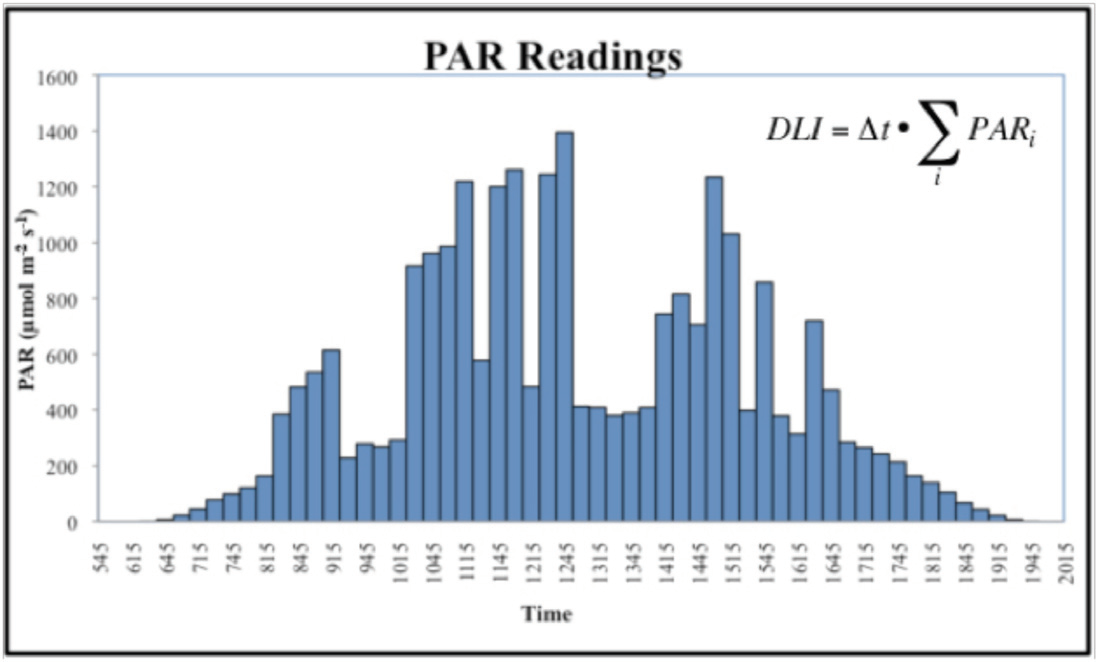Calculating the Daily Light Integral
Printable PDF: Calculating the Daily Light Integral
Instructions for calculating the daily light integral.
Definition of DLI
The daily light integral (DLI) is a measure of the amount of light received in a single day in a particular area. For example, the number of moles of Photosynthetically Active Radiation (PAR) photons received during a single day in a square meter, or: mol m-2 d-1. Another example is the total solar radiation received during a single day in a square meter, or: W m-2. Depending on the application or research question the time integral of incident light may be a more useful tool than the instantaneous incident light. DLI varies depending on latitude, time of year, and cloud cover, and ranges from 5-60 mol m-2 d-1 in the United States for PAR (Korczynski et. al., 2002). In greenhouses or growth chambers, DLI values are typically much lower, which can affect the shoot/root ratio, morphology, and the timing of flowering (Bunnell et. al. 2005 and Ilias et. al. 2005).
How to Measure and Calculate DLI
How to Program the LI-1400 to Calculate DLI
The LI-1400 DataLogger can be set up to automatically calculate DLI for any of the PAR or Pyranometer sensors listed above. This is accomplished by following the Setup Channel menu and choosing Calc=Integral as the logging option. The TCoef value for the channel accounts for the unit conversion. Furthermore in the Logging Setup, set your start and stop time to 00:00 and set the Logging Period to 24 Hours. The sampling period can be set to a value that allows you to capture instantaneous fluctuations with enough resolution. You can find more information about this in the LI-1400 instruction manual on pages 4-6, 7 and 4-27, 28.
Converting Instantaneous Readings to DLI
On the other hand, if your logging was not set up to automatically do the DLI calculations, DLI can still be calculated from the instantaneous values. For example, let’s assume instantaneous PAR readings were taken every 15 minutes during the day using an LI-190R quantum sensor. In Figure 1‑1 we plot the data as a function of time. The DLI is simply the area under this curve. For discrete points the integration can be substituted by a summation. The simplest way to calculate the area under this curve is to calculate the area of each individual ‘rectangular’ area (bar) and sum all of the calculated areas together to get the total area.
1‑1
As long as the instantaneous measurements are made at regular intervals, then Δti is the same for all terms in the summation. Therefore it can be taken out of the summation as a common which leaves only summing over the instantaneous PAR readings.

For the example data, Δt = 900 s (15 min = 15*60 s = 900 s) and ΣiPARi = 25073.236 μmol m-2 s-1. Therefore, the DLI = 900 * 25073.236 = 22568912.4 μmol m-2 d-1. However, while the summation results are given in units of μmol m-2 d-1 DLI is given in units of mol m-2 d-1. Therefore the last step is to do a unit conversion from μmol to mol by simply dividing by 1,000,000.
1‑222568912.4 μmol m-2 d-1 =22568912.4 × 10-6 mol m-2 d-1 = 22.57 mol m-2 d-1
Therefore, to convert from instantaneous PAR readings to daily light integral (DLI): 1) add all PAR readings; 2) multiply by the time interval in seconds between measurements; 3) divide by 1,000,000 to complete the unit conversion.
References
| 1 | P. C. Korczynski, J. Logan, and J. E. Faust. 2002. Mapping monthly distribution of daily light integrals across the contiguous United States. Hort. Tech. 12:12-16. |
| 2 | F. Ilias and Nihal Rajapakse. 2005. The Effects of End-of-the-day Red and Far-red Light on Growth and Flowering of Petunia × hybrida ‘Countdown Burgundy’ Grown under Photoselective Films HortScience February 2005 40:131-133. |
| 3 | B. Todd Bunnell, Lambert B. McCartya, James E. Fausta, William C. Bridges and Nihal C. Rajapaksea. 2005. Quantifying a Daily Light Integral Requirement of a ‘TifEagle’ Bermudagrass Golf Green. |